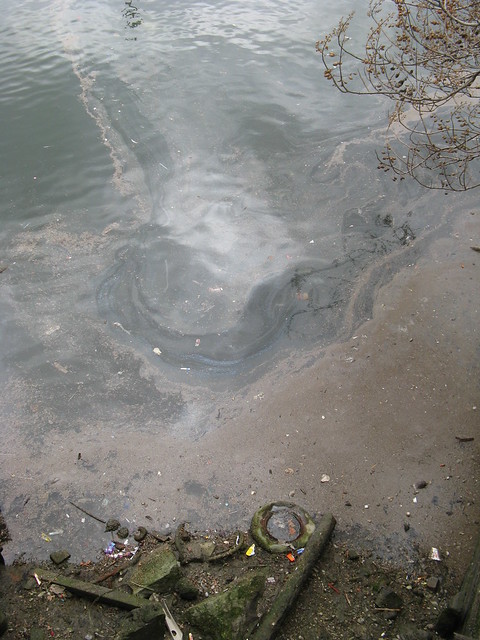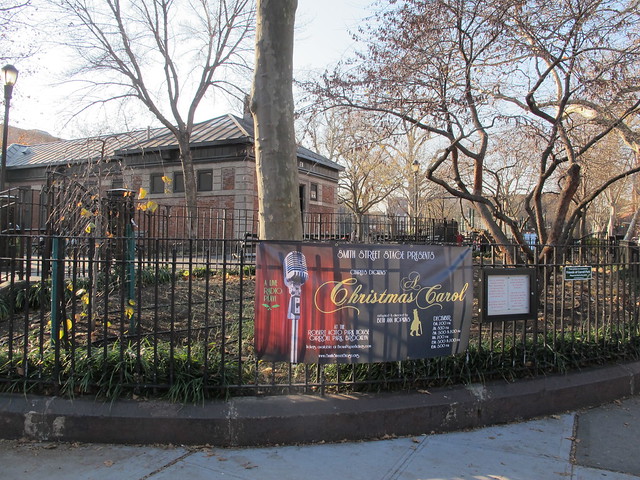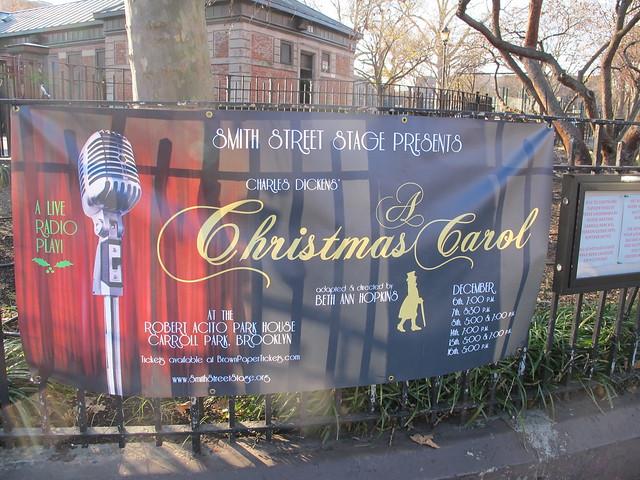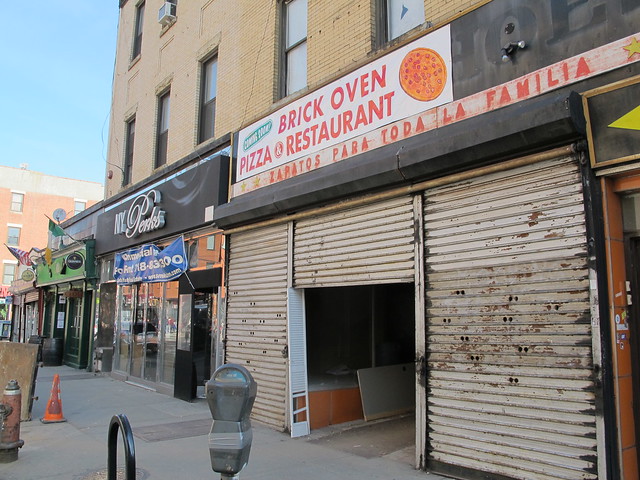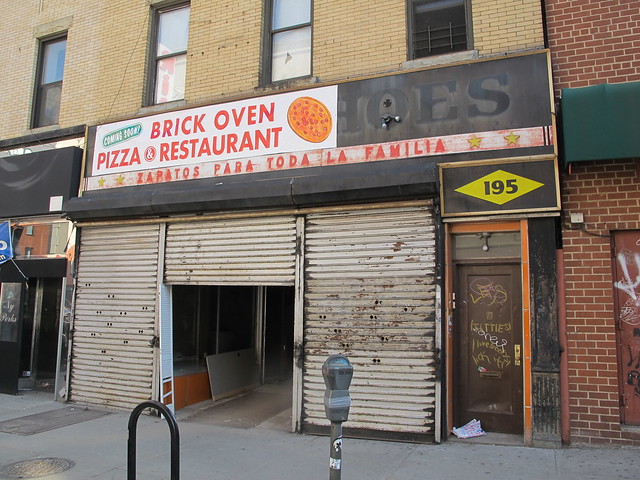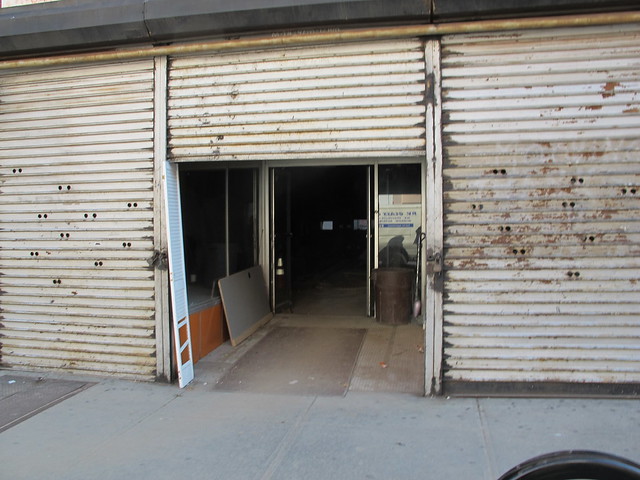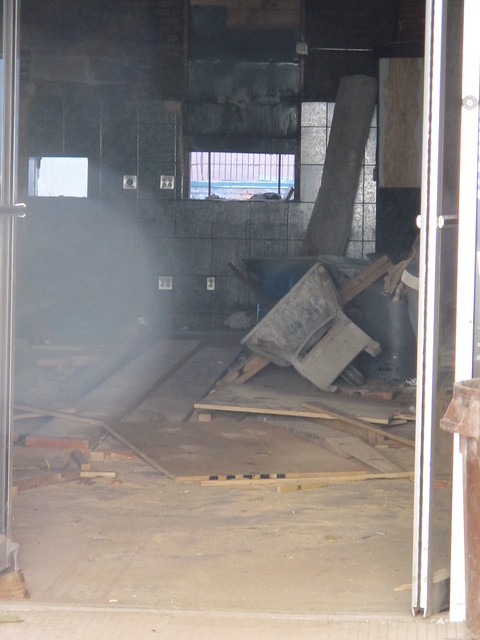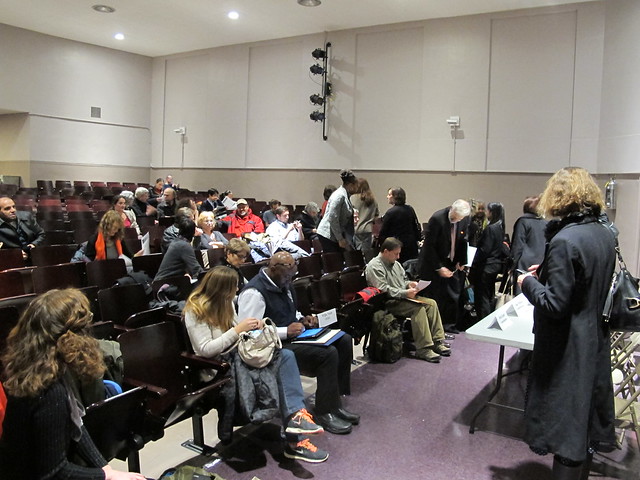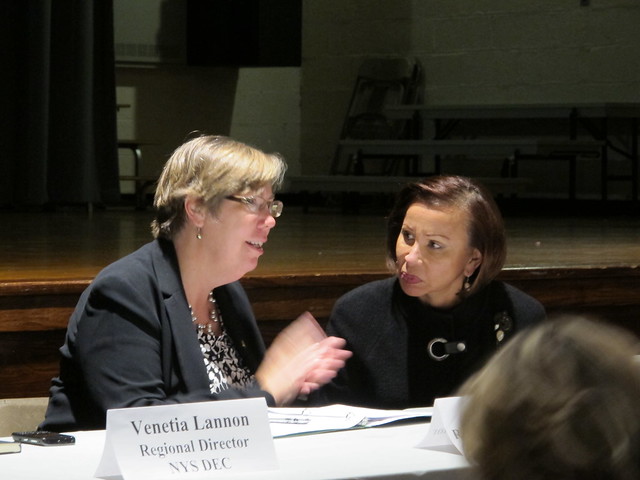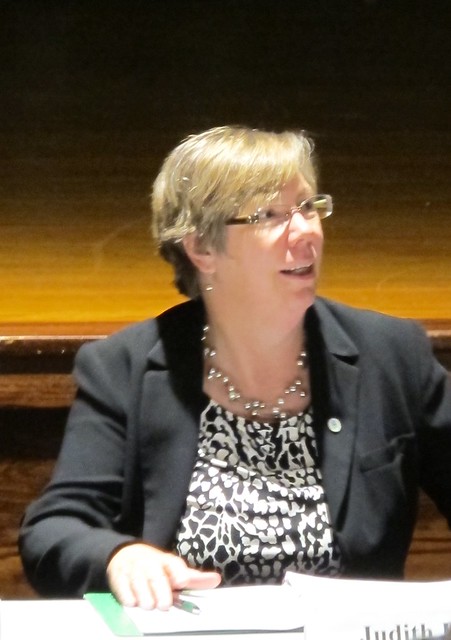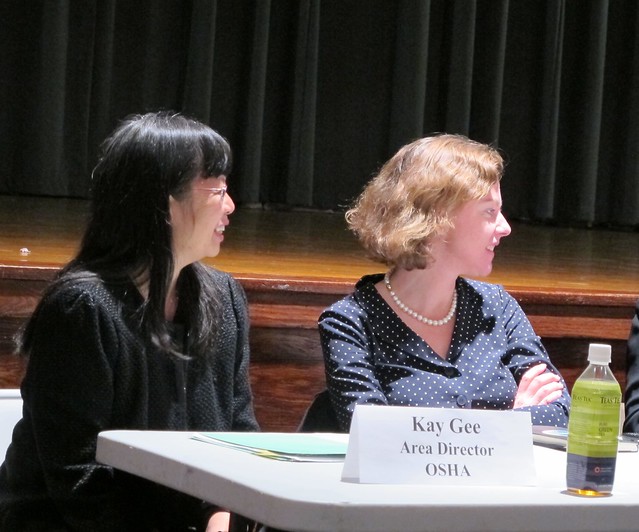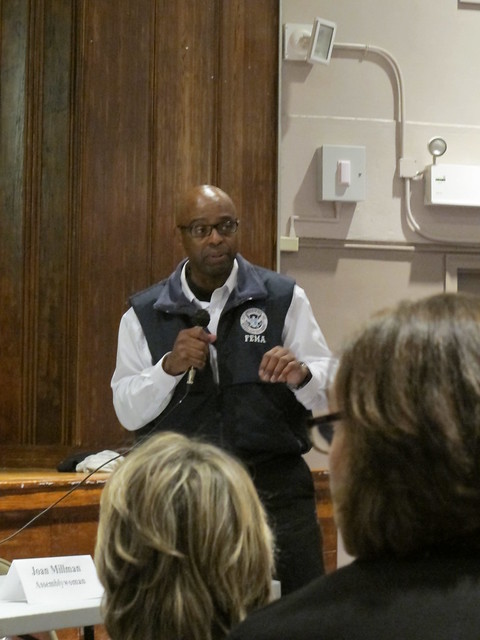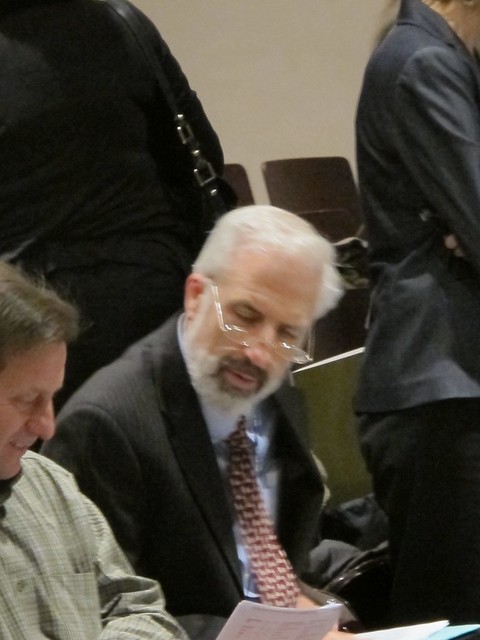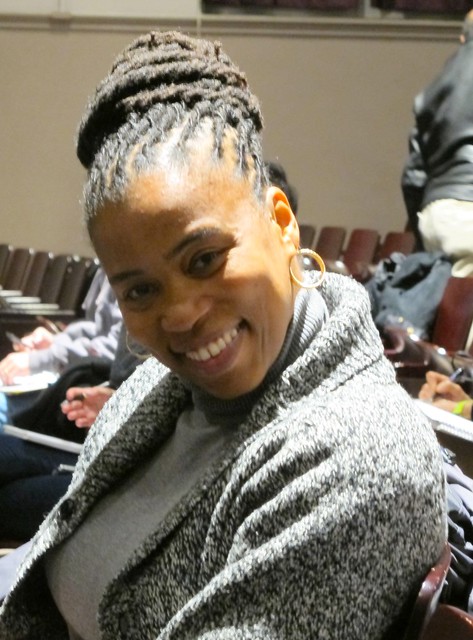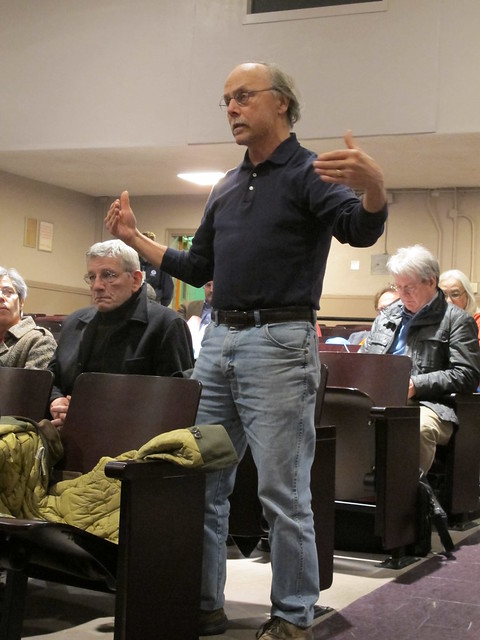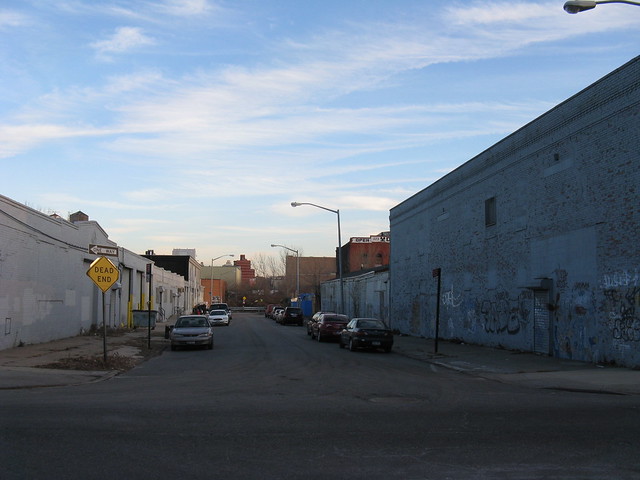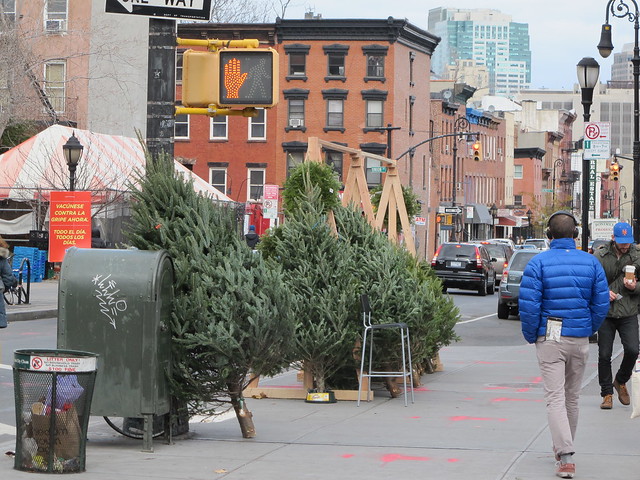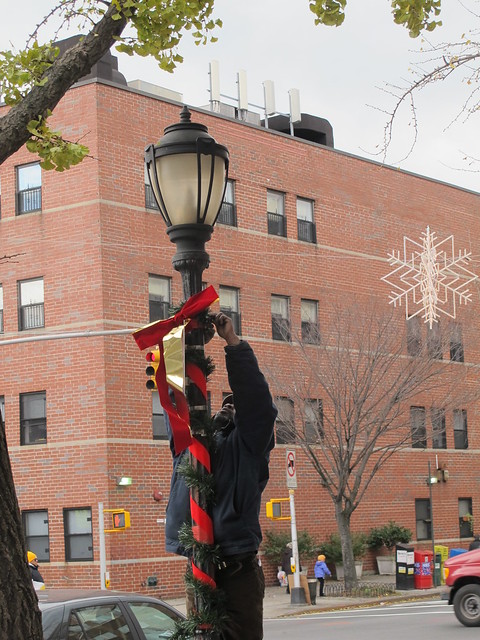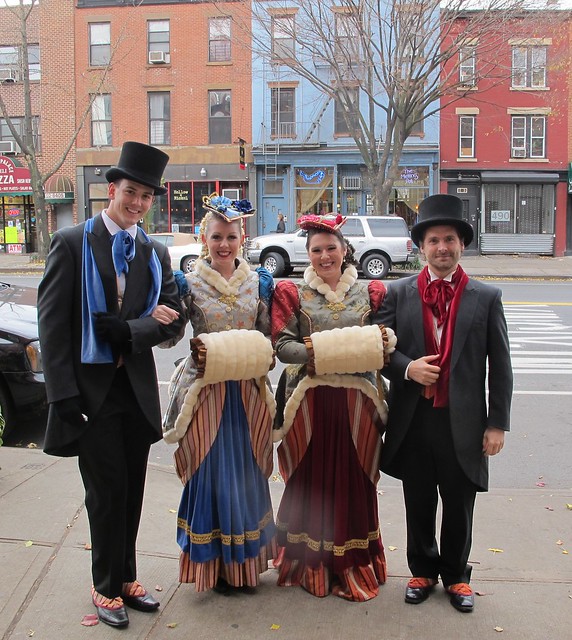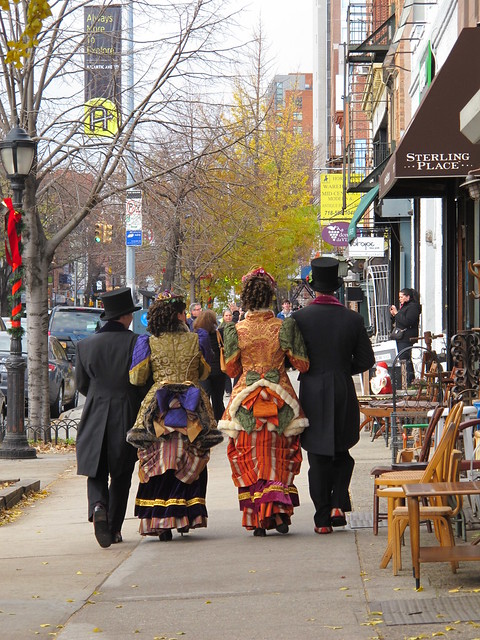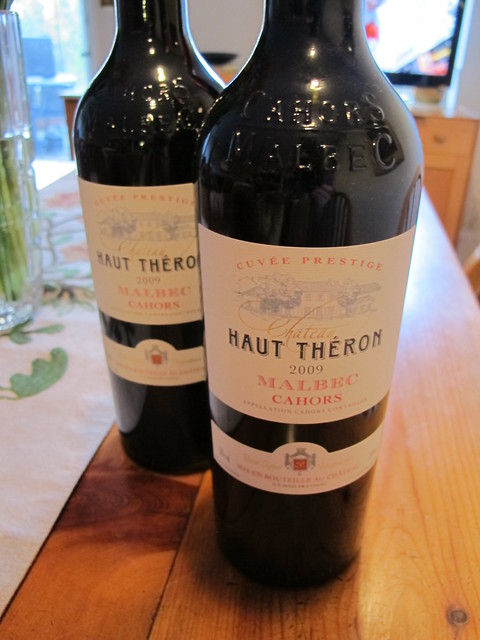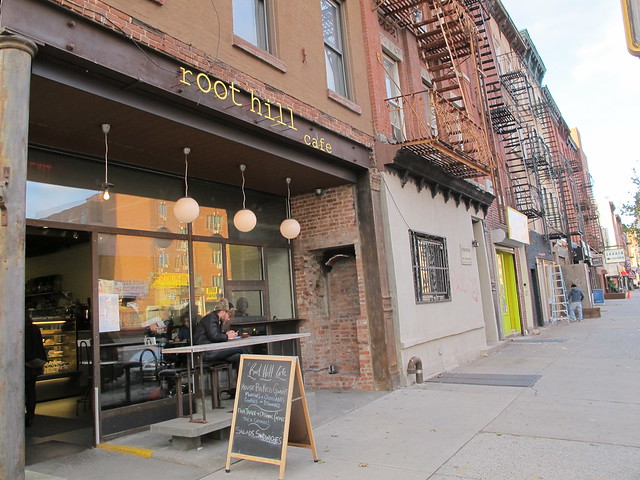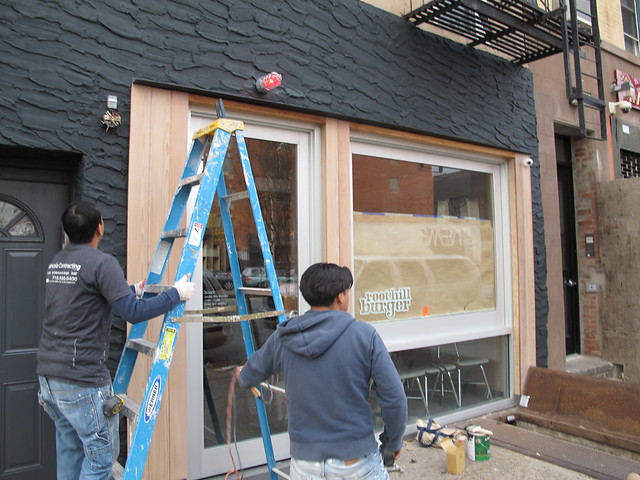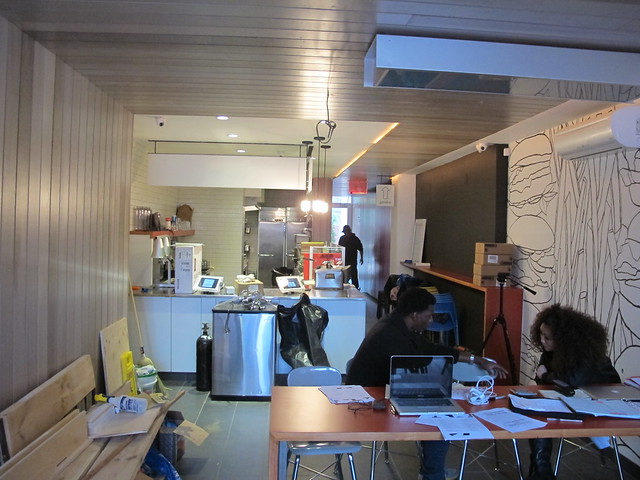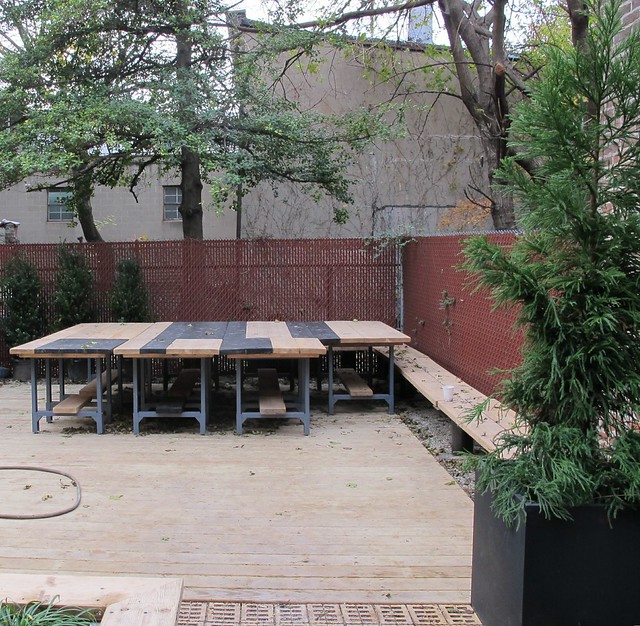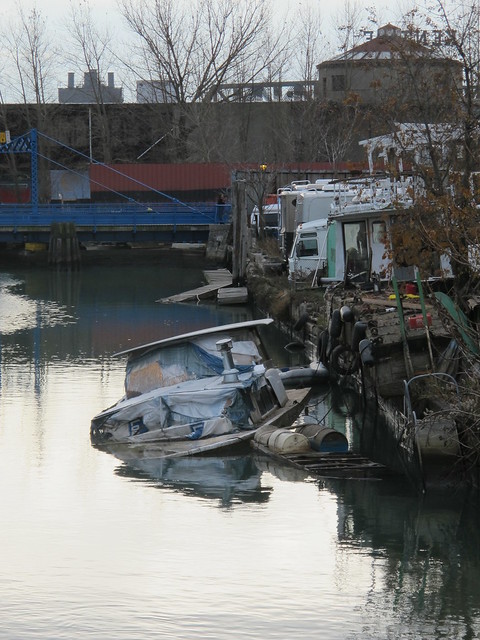Best Comment Of The Day: As Much As The Next Guy
Anonymous has left a new comment on your post "Former Robin Des Bois On Smith Street To Become Brick Oven Pizza Place":
And over on Pardon Me For Asking's Facebook page, Liz felt: "We need really something healthy, vegetarian, wifi space, organic juices, kid friendly, really anything but pizza (or a nail place!) Hope it happens soon!"
"Pizza. It's the new Thai." added Cynthia, and Rachel said: "Jeez ANOTHER?! Serious 2 just opened on my block, 4 blocks from there. COFFEE SHOP + BAR WITH WIFI FOR FREELANCERS! Starbucks is so crowded."
If you haven't joined our Facebook page yet, we would love you to 'like' us here.
I love pizza as much as the next guy but Smith needs another pizza place like it needs another nail salon. Where did all the good restaurants go?????
And over on Pardon Me For Asking's Facebook page, Liz felt: "We need really something healthy, vegetarian, wifi space, organic juices, kid friendly, really anything but pizza (or a nail place!) Hope it happens soon!"
"Pizza. It's the new Thai." added Cynthia, and Rachel said: "Jeez ANOTHER?! Serious 2 just opened on my block, 4 blocks from there. COFFEE SHOP + BAR WITH WIFI FOR FREELANCERS! Starbucks is so crowded."
If you haven't joined our Facebook page yet, we would love you to 'like' us here.
Gowanus Canal Community Advisory Group To Meet With NY State DEC Representatives. Public Invited
The EPA Gowanus Canal Community Advisory Group will be meeting with representatives of New York State's Department Of Environmental Conservation on December 4th, to speak about the agency's role as it relates to the Superfund clean-up as well as the issue of Combined Sewer Overflow that continue to discharge into the canal.
Representing the DEC will be James Tierney, Robert Schick, Venetia Lannon, and Gary Kline.
Below is the meeting announcement from the CAG
Representing the DEC will be James Tierney, Robert Schick, Venetia Lannon, and Gary Kline.
Below is the meeting announcement from the CAG
The public is invited to attend a meeting of the Gowanus Canal Community Advisory Group (CAG) with senior-level officials from the NY State Department of Environmental Conservation (NYSDEC) on December 4 from 6 p.m. – 8 p.m. at PS 32, 317 Hoyt Street, Brooklyn.
Your presence at this meeting will help demonstrate the community’s strong support for a comprehensive clean-up of the canal. The CAG will be asking NYSDEC officials pointed questions about the state’s role in the enforcement of Clean Water Act requirements to eliminate sewage overflows, whether and how the state is coordinating with EPA’s Superfund cleanup process, and other issues of vital importance to a proper clean-up of the canal and protection of public health.
NYSDEC is the only agency that has the right to review and provide comments to EPA on EPA’s Superfund clean-up plan prior to its release, which is expected by the end of 2012. The CAG encourages a strong public turnout at this meeting to show NYSDEC the community’s concern that the clean-up be done right. Questions and comments will be collected from members of the public at the meeting to be answered by NYSDEC as time permits, or to be submitted for later response.
Smith Street Stage Presents Charles Dickens' Christmas Carol (A Radio Play) In Carroll Park
Over the last three summers, Smith Street Stage, a theatre group based in Carroll Gardens, has brought Shakespeare to Carroll Park. Their productions of 'Romeo and Juliet' in 2010, 'Macbeth' in 2011 and "Twelfth Night" in 2012 have delighted local residents.
This holiday season, they are presenting Charles Dickens' "Christmas Carol" in the form of a live radio play at the Robert Acido Park House in Carroll Park. It should be great fun.
Below is all the info:
To buy your tickets, click here http://www.brownpapertickets.com/event/289393
This holiday season, they are presenting Charles Dickens' "Christmas Carol" in the form of a live radio play at the Robert Acido Park House in Carroll Park. It should be great fun.
Below is all the info:
Smith Street Stage retell the famous Dickens classic inside the Park House at Carroll Park. Seven actors bring 34 characters to life through the magic of radio. Most of the sound effects will be created by the actors themselves.
Tickets are $10 for adults, $8 for children.Smith Street Stage Presents:Charles Dickens' "Christmas Carol"at the Carroll Park Park houseCorner of President Street and Smith StreetStarring: Patrick McCarthy, Susanna Baddiel, Jessica Weiss, Charlie Kravits, Pete McElliot, Sam Rosenberg and Jonathan HopkinsDecember 6th, 7:00 p.m.December 7th, 8:30 p.m.December 8th, 5:00 and 7:00 p.m.December 14th, 7:00 p.m.December 15th, 5:00 and 7:00 p.m.December 16th, 5:00 p.m
To buy your tickets, click here http://www.brownpapertickets.com/event/289393
Former Robin Des Bois On Smith Street To Become Brick Oven Pizza Place
Many in the neighborhood still miss "Robin Des Bois", the french bistro and wine bar with a fun eclectic decor and a much-loved back yard at 195 Smith Street. The eatery opened in a former shoe store a few years ago and quickly became a favorite on restaurant row, before closing in December 2011. In the last few months, the storefront and the apartments above it have been undergoing renovation. Just a few days ago, a sign went up indicating that the retail space will soon become a brick oven pizza place.
A quick glance inside shows that there is still lots of work to do before a grand opening.
It's a bit disappointing that the space won't be used for something more along the lines of 'Robin.'
There are already quite a few pizza places on Smith Street.
A quick glance inside shows that there is still lots of work to do before a grand opening.
It's a bit disappointing that the space won't be used for something more along the lines of 'Robin.'
There are already quite a few pizza places on Smith Street.
Don't Miss Etsy New York's Fifth Annual Holiday Handmade Cavalcade
on
|
If you are planning on doing some holiday shopping, mark this event on your calendar. The Handmade Cavalcade on December 1st and 2nd is organized by the Etsy NY Team and features the work of 35 local artists and crafters. It is the perfect antidote to department store shopping. Don't miss it.
Here is more info:
Santa’s Workshop isn’t the only place to find quality, handcrafted items for the Holidays. New York has its own enclave of busy craftspeople who work all year long to create one of a kind items that make truly unique gifts for everyone on your list. These modern day elves, The Etsy NY Team, are a collective of local artists, artisans, designers and crafters who sell on Etsy.com, the largest online marketplace for handmade goods.Here is a list of all the vendors who will be displaying their wares.
The Etsy NY Team shares its handmade artistry at the Fifth Annual Holiday Handmade Cavalcade the weekend of December 1st and 2nd, from 11am – 6pm at The Space at 50 N. 3rd St Williamsburg Brooklyn. Forty designers and crafters, all living and creating in the metropolitan area, will take over the space with perfect gifts: one-of-a-kind handmade clothing, jewelry, accessories, paper goods, bath and body treasures, toys, and housewares.
“With a turnout of more than 2,000 people each year, the Holiday Handmade Cavalcade is fast becoming a great New York City winter tradition,” says Felicity Stiverson, the event’s coordinator. “For the first weekend of December, we will transform Williamsburg’s “The Space,” into a holiday shopping wonderland.” In addition to the high-quality, handmade wares for sale, visitors will have the opportunity to participate in winter-themed crafting demonstrations, interact with our event sponsors, including Outright, Yelp, Purl SoHo, Lion Brand Yarn, ECOBags Brand, and Brooklyn Charm, and mingle with local artisans in our lounge over delectable treats. “The adventurous shopper will not want to miss this opportunity to choose from the fantastic designs locally crafted by this year’s eclectic and talented mix of vendors,” Stiverson said.
Admission to this indie shopping event is free. “Make sure to arrive early: the first 100 guests both Saturday and Sunday will receive a free gift bag filled with wonderful treasures donated by The Etsy NY team and the event sponsors,” Felicity said. “Shoppers can also enter to win one of five tote bags filled with extra-special handmade items.”
At Community Meeting, EPA Answers Gowanus Residents' Questions Regarding Sandy Flooding
Judith Enck, EPA Regional Manager of Region 2 and Congresswoman Nydia Velázquez
Judith Enck, EPA Regional Manager of Region 2
Congresswoman Nydia Velázquez
Councilmember Brad Lander
Assemblywoman Joan Millman
Kay Gee, Area Director of Osha and Venetia Lannon, Regional Director, NYS DEC
Willie Nunn, FEMA Division D Supervisor, Brooklyn
Natalie Loney ,EPA Region 2 Community Involvement Coordinator
To address continuing concerns about the floodwater and the sludge left behind when the Gowanus Canal, an EPA Superfund site, overflowed its banks during Hurricane Sandy last month, Congresswoman Nydia Velázquez held an informational meeting for local residents last night at PS 32 on Hoyt Street. The meeting was co-sponsored by State Senator Daniel Squadron, State Senator Velmanette Montgomery, Assemblywoman Joan Millman, Councilmember Steve Levin, and Councilmember Brad Lander. In attendance were Judith Enck, EPA Regional Manager of Region 2 , as well as representatives from Occupational Safety and Health Administration (OSHA), Federal Emergency Management Agency (FEMA), and New York State Department of Environmental Conservation.
Judith Enck told the audience that she came out to the Gowanus area personally the afternoon after the storm and observed a 'most disturbing petroleum sheen' on the waterway. She explained that her agency collected samples from the canal on October 31, 2012. They also took four samples from the ground floors of two buildings that had been flooded during the storm. One of the buildings is located at the head of the canal, and the other near the 3rd Street turning basin.
Sampling was repeated on November 4th, 5th and 9th.
The samples of flood water from those two buildings were analyzed for both bacteria and for 139 different chemicals within the following categories: metals, volatile organic compounds, petroleum related compounds and semi-volatile organic compounds like polycyclic aromatic hydrocarbons (PAHs) which are the primary contaminants in Gowanus Canal sediment.
Analysis of the samples showed bacteria levels to be very high. It also indicated low- level traces of gasoline and petroleum, consistent with storm run-off.
However, toxin levels were either below levels that would trigger concern or not detected at all. It would appear that there was no scouring of the bottom of the canal during the storm and that the toxic sediment remained undisturbed.
The main concern for Gowanus home owners whose houses were flooded are mold and bacteria. Bacteria can be traced directly to the raw sewage and street run-off that discharges from the Combined Sewage Overflows (CSOs) in the Canal.
Enck suggested common sense steps to deal with mold and bacteria. She stressed the importance of wearing protective clothing, rubber boots, rubber gloves, googles and facial masks. "Bacteria will die off eventually," Enck explained. However, if not dealt with properly, it can compromise the immune system." For extra precaution, a Tetanus booster may be recommended.
Enck stated that the EPA is committed to being transparent and will continue to provide information to this web site: http://www.epa.gov/sandy
It was clear from comments from the audience that many home-owners and renters were still dealing with a host of issues almost three weeks after the hurricane. One owner reported still not having power. A renter expressed frustration that her landlord had not even pumped out his basement yet. Another resident mentioned that oil residue from the flood water had coated basements and sidewalks and that some of her neighbors had used brake fluid to dilute the sticky film.
The conversation quickly turned to the lessons that can be learned from this storm. Many, including the elected officials at the meeting, were in agreement that sea level rise and global warming is a reality and needs to be factored into any future development along the Gowanus.
Congresswoman Velázquez spoke of the need to set public policy and of a revision of the type of development allowed along the coastline. "This is a new reality" she stated. "It offers an opportunity for recovery, preservation and mitigation."
Councilman Lander felt that this is a very important time, one which offers a re-set button in regards to development on the shores of the Gowanus Canal. He mentioned that FEMA will be redrawing their existing flood maps to reflect flood lines during Hurricane Sandy. "We also need to keep pushing for infrastructure change."
Several people, including Jim Vogel of State Senator Velmanette Montgomery's office, called for a moratorium on building on the shores of the Gowanus until all risks are assessed, until the City stops using the canal as a cess pool, building codes and zoning rules for coastal areas are reviewed, but most importantly, until we all come to terms with the fact that we may not have to wait 100 years for a storm like Sandy to recur.
In Regards To Lightstone Group's 'Minor Modifications' For Gowanus Project, Brooklyn Law School Clinic Finds Department Of City Planning In Violation Of Article 78.
Image of proposed development courtesy of The Lightstone Group
To read the letter in its entirety, click here
Brooklyn Law School Community Development Clinic recently sent a letter to Amanda Burden, Chairperson of New York City's Department Of City Planning (DCP) on behalf of Friends And Residents of Greater Gowanus (FROGG) urging her agency to take no further action on the Lightstone Group's application for a modification to its previously approved special permit related to a proposed large- scale general development project at 363-365 Bond Street in Gowanus, Brooklyn.
Hoping to piggy-back on the former Toll Brothers project, which called for 447 condo units on the shores of the Gowanus Canal, Lightstone is seeking DCP's approval for variations in the base height of the project, building heights and footprints of portions of the buildings, relocation of parking entrances, changes to the location and design of the open space, and changes to the number of residential units from 447 to 700.
DCP considers these changes "minor" modification's which are subject to review and approval only by the Commission, rather than 'major' modifications, which would require the initiation of a new ULURP.
DCP considers these changes "minor" modification's which are subject to review and approval only by the Commission, rather than 'major' modifications, which would require the initiation of a new ULURP.
*DCP’s consideration and administrative approval of “minor modification” applications outside the Uniform Land Use Review Procedure1 (“ULURP”) is ultra vires and therefore null and void.
The findings confirm what many Gowanus area residents have been suspecting for a long time: that the DCP 'minor modification' process was flawed from the beginning and that it allowed the developer to circumvent the usual ULURP process.
Ironically, Brooklyn Law School Community Development Clinic's letter was delivered to Amanda Burden in time to be considered for DCP's deliberations on the Lightstone matter that were scheduled for Monday Oct 29th, 2012, the day Hurricane Sandy flooded the city and this proposed development site with a 14 foot storm surge. The meeting has yet to be rescheduled.
October 26, 2012
DirectorAmanda Burden,
New York City Department of City Planning
22 Reade Street
New York, New York 10007
I. DCP’s consideration and administrative approval of “minor modification” applications outside ULURP is ultra vires and therefore null and void.
DCP argues that a “minor modification” to a previously approved special permit does not require a new ULURP application and is not subject to City Council review. See Karnovsky Letter. Admittedly, DCP has the authority to approve “minor modifications” to special permit applications during the ULURP process.
This is apparent in Windsor Owners Corp. v. City Council of City of New York, 23 Misc.3d 490 (Sup. Ct., N.Y. Cty. 2009). There, as is proper under the ULURP rules, the City Council proposed modifications to a ULURP application and “remanded” it to the City Planning Commission (“CPC”) for review. The CPC applied the criteria set forth in 62 R.C.N.Y § 2-06(g) (5), to determine that the modifications were “minor,” meaning that the plan did not have to go through ULURP again and was not subject to additional public hearing. However, the CPC’s determination was subject to, and ultimately received, City Council approval.
The Karnovsky Letter failed to cite any legal authority that would extend Windsor’s holding to previously approved ULURP applications. If DCP relies on Section 2-06 of the ULURP rules as a textual basis for its “authority” here, such reliance is misplaced. As Windsor makes clear, that section applies to proposed modifications during the ULURP process, before the City Council makes its final decision.
In addition, even if DCP’s authority to approve “minor modifications” extended to previously approved special permits, The Karnovsky letter also failed to explain why such approval is not subject to City Council review. While it is true that not all special permit applications or modifications thereto are automatically subject to Council approval, City Council may, in any case, “take up” the application for an up or down vote. See New York City Charter §§ 197-d(b)(2)-(3) & 197-c(a)(4); 62 R.C.N.Y § 2-06(g)(5)(ii). Thus, DCP’s stated course of action -- to consider and approve TLG’s application despite the fact it is outside ULURP -- is outside the scope of its legislatively delegated authority and is therefore null and void.3 See Eastport Alliance, 13 A.D.3d at 529; Old Dock Assoc. v. Sullivan, 150 A.D.2d 695, 697 (2d Dep’t. 1989).
II. DCP’s determination does not carry the force of law because the rule that DCP applies to evaluate proposed modifications was not adopted pursuant to CAPA’s strict requirements.
Even if legislature had authorized DCP’s administrative approval mechanism, the standard by which DCP evaluates proposed modifications is a “rule” subject to CAPA4, and was not adopted in accordance with CAPA’s strict rulemaking requirements. CAPA provides the following definition:
5. "Rule" means the whole or part of any statement or communication of general applicability that (i) implements or applies law or policy, or (ii) prescribes the procedural requirements of an agency including an amendment, suspension, or repeal of any such statement or communication.
a. "Rule" shall include, but not be limited to, any statement or communication which prescribes... (iii) standards for the issuance, suspension or revocation of a license or permit...
N.Y.C. Charter § 1041 (emphasis added).
*DCP’s determination does not carry the force of law because the rule that DCP applies to evaluate proposed modifications was not adopted pursuant to the strict requirements of the City Administrative Procedure Act2 (“CAPA”).
*DCP's failure to account for the proposed increase in floor area, a mandatory consideration under DCP's impermissible rule, "was arbitrary and capricious and in violation of applicable law. " N.Y.C.P.L.R. 7803 (3).
*DCP's failure to account for the proposed increase in floor area, a mandatory consideration under DCP's impermissible rule, "was arbitrary and capricious and in violation of applicable law. " N.Y.C.P.L.R. 7803 (3).
The findings confirm what many Gowanus area residents have been suspecting for a long time: that the DCP 'minor modification' process was flawed from the beginning and that it allowed the developer to circumvent the usual ULURP process.
Ironically, Brooklyn Law School Community Development Clinic's letter was delivered to Amanda Burden in time to be considered for DCP's deliberations on the Lightstone matter that were scheduled for Monday Oct 29th, 2012, the day Hurricane Sandy flooded the city and this proposed development site with a 14 foot storm surge. The meeting has yet to be rescheduled.
You can read the Brooklyn Law School letter in its entirety after the jump by clicking here
BLS Legal Services Corp. Community Development Clinic
David Reiss
Director
DirectorAmanda Burden,
New York City Department of City Planning
22 Reade Street
New York, New York 10007
Dear Ms. Burden,
We write on behalf of the Friends and Residents of Greater Gowanus (FROGG). FROGG is a not-for-profit community organization devoted to the preservation of the history and heritage of the Gowanus area in South Brooklyn. The Lightstone Group (“TLG”) submitted an application to the Department of City Planning (“DCP”) for a modification (M 090048(A) ZSK) to its previously approved special permit (C 090048 ZSK) related to a proposed large- scale general development project at 363-365 Bond St., Brooklyn, New York. DCP now seeks to approve the application based on its “determination” that the proposed modifications are “minor.” See David Karnovsky’s letter to Brad Lander (“Karnovsky Letter”), attached. FROGG vigorously opposes DCP’s approval for the following reasons:I. DCP’s consideration and administrative approval of “minor modification” applications outside the Uniform Land Use Review Procedure1 (“ULURP”) is ultra vires and therefore null and void.
II. DCP’s determination does not carry the force of law because the rule that DCP applies to evaluate proposed modifications was not adopted pursuant to the strict requirements of the City Administrative Procedure Act2 (“CAPA”).
III. DCP’s failure to account for the proposed increase in floor area, a mandatory consideration under DCP’s impermissible rule, was “arbitrary and capricious and in violation of applicable law.” N.Y. C.P.L.R. 7803(3).
I. DCP’s consideration and administrative approval of “minor modification” applications outside ULURP is ultra vires and therefore null and void.
DCP argues that a “minor modification” to a previously approved special permit does not require a new ULURP application and is not subject to City Council review. See Karnovsky Letter. Admittedly, DCP has the authority to approve “minor modifications” to special permit applications during the ULURP process.
This is apparent in Windsor Owners Corp. v. City Council of City of New York, 23 Misc.3d 490 (Sup. Ct., N.Y. Cty. 2009). There, as is proper under the ULURP rules, the City Council proposed modifications to a ULURP application and “remanded” it to the City Planning Commission (“CPC”) for review. The CPC applied the criteria set forth in 62 R.C.N.Y § 2-06(g) (5), to determine that the modifications were “minor,” meaning that the plan did not have to go through ULURP again and was not subject to additional public hearing. However, the CPC’s determination was subject to, and ultimately received, City Council approval.
The Karnovsky Letter failed to cite any legal authority that would extend Windsor’s holding to previously approved ULURP applications. If DCP relies on Section 2-06 of the ULURP rules as a textual basis for its “authority” here, such reliance is misplaced. As Windsor makes clear, that section applies to proposed modifications during the ULURP process, before the City Council makes its final decision.
In addition, even if DCP’s authority to approve “minor modifications” extended to previously approved special permits, The Karnovsky letter also failed to explain why such approval is not subject to City Council review. While it is true that not all special permit applications or modifications thereto are automatically subject to Council approval, City Council may, in any case, “take up” the application for an up or down vote. See New York City Charter §§ 197-d(b)(2)-(3) & 197-c(a)(4); 62 R.C.N.Y § 2-06(g)(5)(ii). Thus, DCP’s stated course of action -- to consider and approve TLG’s application despite the fact it is outside ULURP -- is outside the scope of its legislatively delegated authority and is therefore null and void.3 See Eastport Alliance, 13 A.D.3d at 529; Old Dock Assoc. v. Sullivan, 150 A.D.2d 695, 697 (2d Dep’t. 1989).
II. DCP’s determination does not carry the force of law because the rule that DCP applies to evaluate proposed modifications was not adopted pursuant to CAPA’s strict requirements.
Even if legislature had authorized DCP’s administrative approval mechanism, the standard by which DCP evaluates proposed modifications is a “rule” subject to CAPA4, and was not adopted in accordance with CAPA’s strict rulemaking requirements. CAPA provides the following definition:
5. "Rule" means the whole or part of any statement or communication of general applicability that (i) implements or applies law or policy, or (ii) prescribes the procedural requirements of an agency including an amendment, suspension, or repeal of any such statement or communication.
a. "Rule" shall include, but not be limited to, any statement or communication which prescribes... (iii) standards for the issuance, suspension or revocation of a license or permit...
N.Y.C. Charter § 1041 (emphasis added).
This definition is broad by design. See Report of the New York City Charter Revision Commission: December 1986—November 1988, at 86 (Apr. 1989) (“The term “general applicability” encompasses any statement or communication that applies similarly to members of a class, regardless of the number of members in any such class....The definition is intended to be construed broadly to accommodate the act’s basic objectives.”).
New York Courts have broadly interpreted CAPA’s definition of “rule” as well. In 1700 York Assoc. v. Kaskel, 182 Misc.2d 586 (Civ. Ct., N.Y. Cty. 1999), the Court found that a city agency’s policy prohibiting the keeping of ferrets as domestic pets was a “rule” under CAPA. The agency based its policy on its interpretation of 24 R.C.N.Y. § 161.01(a), which prohibits keeping an “animal of a species which is wild, ferocious, fierce, dangerous or naturally inclined to do harm” in a residential dwelling. Finding no previous judicial interpretations of the term “general applicability” under CAPA, the Court turned to judicial interpretations under the State Administrative Procedure Act (SAPA) § 102(2)(a)(i), since the “term is used so similarly” there. Id. at 593. The court provided as follows:
A statement “of general applicability” is “a fixed, general principle to be applied by an administrative agency without regard to other facts and circumstances relevant to the regulatory scheme.” The statement need not regulate the general public; if a policy is to be “invariably applied across-the-board” to the segments of the population within its ambit “without regard to individual circumstances or mitigating factors.... [it] falls plainly within the definition of a ‘rule.’Since the policy in question extended “invariably across the board” to anyone who had a pet ferret, the Court concluded that this decision constituted a “rule” of “general applicability” which was not adopted pursuant to CAPA’s rulemaking requirements and was thus not entitled to the “force and effect of law.” Id. at 593-94 (quoting Schwartfigure v. Hartnett, 83 N.Y.2d 296, 301 [1994]). See Cordero v Corbisiero, 80 N.Y.2d 771, 773 (1992) (The Court of Appeals struck down the State Racing and Wagering Board’s policy of imposing one-race suspensions on horse jockeys for certain infractions, concluding it was a “rule” under SAPA because it was one “of general applicability which prescribe[d] a procedure or practice requirement of the agency.”)
Id. (internal citations omitted).
The New York County Supreme Court in Callahan v. Carey, 2012 N.Y. Slip Op. 30400(U) (Trial Order), defined the contours of CAPA’s “rule” definition, including a description of the characteristics that distinguish a “rule” from an “interpretive policy” not subject to CAPA. The Court, also relying on interpretations of SAPA for guidance, explained as follows:
CAPA's rule making process is mandated when an agency establishes precepts that remove its discretion by dictating specific results in particular circumstances. Only a fixed general principle to be applied by an administrative agency, without regard to other facts and circumstances relevant to the regulatory scheme of the statute it administers, constitutes a rule or regulation that must be formally adopted. Rules are not implicated where there is the ability for ad hoc decision making or where decision makers are vested with significant discretion to independently exercise their professional judgment. Nor are rules implicated by interpretative statements, or statements of general policy, that have no legal effect.Citing the Court of Appeals, The Supreme Court acknowledged that rules are “generally broader and [have] more direct public impact than.... interpretative policies,” and there is “no clear bright line between [the two].” Id. The inquiries necessary to make the distinction, therefore, are “necessarily circumstance driven,” and “turn on matters of degree.” Id.
Id. (citations omitted).
In that case, the procedure in question “sets forth the standards by which [the Department of Homeless Services (“DHS”)] will determine whether individuals who apply for temporary housing assistance are eligible.” Id. The policy stated that “DHS will utilize this Procedure to determine whether an applicant for THA is an eligible homeless person. This determination will be based on an assessment of whether the applicant has a viable housing option where s/he can live even on a temporary basis...” Callahan, 2012 N.Y. Slip Op. 30400(U) (emphasis in original). DHS is then required to make its determination based upon the “totality of the applicant's circumstances, with an analysis of each applicant's situation in accordance with all relevant factors including those enumerated in [the policy].” Id. Despite the ad hoc nature of the standard and its “broad language,” the court concluded the procedure was nonetheless a “rule” subject to CAPA because it applied to all applicants for temporary housing and was based on “criteria that are outcome determinative...” Id.
DCP’s criteria for determining whether proposed modifications are “minor” are those set forth in the ULURP rules governing the CPC’s authority to determine whether modifications proposed by Council during ULURP, require the initiation of a new ULURP application. The rules provide as follows:
DCP’s criteria for determining whether proposed modifications are “minor” are those set forth in the ULURP rules governing the CPC’s authority to determine whether modifications proposed by Council during ULURP, require the initiation of a new ULURP application. The rules provide as follows:
[The City Planning Commission] shall have fifteen (15) days to review [Council’s proposed modification] and to determine: ... (ii) whether the modification requires the initiation of a new application. In making this determination, the Commission shall consider whether the proposed modification: (A) increases the height, bulk, envelope or floor area of any building or buildings, decreases open space, or alters conditions or major elements of a site plan in actions (such as a zoning special permit) which require the approval or limitation of these elements; (B) increases the lot size or geographic area to be covered by the action; (C) makes necessary additional waivers, permits, approvals, authorizations or certifications under sections of the Zoning Resolution, or other laws or regulations not previously acted upon in the application ...
If the Commission has determined that no additional review is necessary ..., it shall so report to the Council. The Commission may also transmit any comment or recommendation with respect to the substance of the modification, and any proposed further amendment to the modification which it deems as necessary or appropriate.
62 R.C.N.Y § 2-06(g)(5)(ii) (emphasis added).
As case law and legislative history make clear, DCP’s informal “adoption” of these criteria to evaluate whether a proposed modification is “minor” constitutes a “rule” subject to CAPA for several reasons. First, DCP concedes that these considerations generally apply to all applications for “minor” modifications. Second, as in Callahan, the use of the word “shall” in 62 R.C.N.Y § 2-06(g)(5)(ii) removes DCP’s discretion by mandating the consideration, which necessarily renders “certain” of these criteria to be “outcome determinative.” See Callahan, 2012 N.Y. Slip Op. 30400(U). In fact, DCP’s policy has stronger characteristics of a “rule” than did the policy in Callahan, since one might argue that the policy in that case implicitly allowed some level of discretion insofar as determinations were to be based on the “totality of the applicant’s circumstances.” Id. No such language appears in 62 R.C.N.Y § 2-06(g)(5)(ii).5 Finally, CAPA’s basic goal -- “to provide an open process in agency rulemaking” -- supports finding DCP’s policy to be a “rule.” See New York City Charter Revision Commission, Summary of Final Proposals 6, 1988. Accordingly, since DCP’s rule was not promulgated according to CAPA’s strict requirements, including those for notice, comment, public hearing, and publication, it does not carry the “force and effect of law.” 1700 York Assoc., 182 Misc.2d at 586.
As discussed above, DCP generally considers a modification to be “minor” so long as it does not “increase the extent of any previously granted waivers of underlying use or bulk regulations” or “require new waivers or forms of approval not encompassed within the prior action.” Karnovsky Letter. These criteria are “generally those set forth in Section 2-06(g)(5)(ii) of the ULURP Rules....” Karnovsky Letter.
DCP failed to then properly apply its self-imposed, albeit impermissible, rule to TLG’s application. Specifically, 62 R.C.N.Y § 2-06(g)(5)(ii) mandates that CPC consider increases in floor area. TLG’s proposed modification does, in fact, increase the floor area of the project by 2,834 square feet. See Amanda Burden’s letter to Brooklyn Community Board 6, attached. The Windsor court explained that a modification is minor so long as it does not exceed the original plan with respect to any of the criteria under section 2-06(g)(5)(ii). 23 Misc.3d at 501. If it does exceed the original, despite whether the increase still complies with the underlying zoning restriction, it is a “significant modification” that “require[s] a new ULURP application and public hearing.” Windsor Owners Corp. 23 Misc.3d at 501. The Karnovsky letter is conspicuously silent as to this enlargement. Since consideration of all the factors in Section 2-06(g)(5)(ii) is mandatory, and since the increase in floor area constitutes a “significant modification,” DCP acted in “violation of applicable law” (“applicable” insofar as DCP conceives it, anyway). See N.Y. C.P.L.R. 7803(3).
***
For all the reasons outlined above, FROGG respectfully requests that DCP takes no further action on TLG’s application, which includes making a determination on the application at the upcoming City Planning Commission review session on Monday, October 29, 2012, as such action exceeds DCP’s statutory authority, violates CAPA, and is arbitrary and capricious in violation of applicable law.
Sincerely,
Brooklyn Law School Community Development Clinic
Grady Southard, Legal Intern
Jeffrey Ling, Legal Intern
Sarah Udashkin, Legal Intern
cc:
City Planning Commission
David Karnovsky, Esq.
Hon. Brad Lander
Craig Hammerman, District Manager, Brooklyn Community Board 6 Purnima Kapur, Director, DCP Brooklyn office
Aline Fader, Planner, DCP Brooklyn office
Hon. Velmanette Montgomery, New York State Senator, 18th Senate District Hon. Nydia Velázquez, U.S. Representative, 12th Congressional District
1 N.Y.C. Charter §§ 197-c & -d; 62 R.C.N.Y § 2-01 et seq.
2 N.Y.C. Charter §§ 1041 - 1046
3 Moreover, “[w]here a local land use agency acts without jurisdiction in approving or denying a site plan, special
permit, or other land use application, a challenge to such an administrative action, as ultra vires, is not subject to the 30–day limitations period” for land use determinations. Eastport Alliance v. Lofaro, 13 A.D.3d 527, 529 (2d Dep’t. 2004).
4 CAPA applies here despite N.Y.C. Charter § 1041(b)(vi), which exempts certain ULURP actions from CAPA’srequirements. If we assume that that the DCP mechanism at issue (1) is a ULURP action, and (2) that it qualifies for this exemption, DCP would exceed its scope of authority by not subjecting its determination to Council Review as ULURP would require. Thus, either CAPA applies, or DCP’s mechanism is null and void. See Eastport Alliance, 13 A.D.3d at 529.
5 Any level of “discretion” this section might seem to grant to CPC say, for example,-- based on its right to propose additional modifications that it deems “appropriate” -- would necessarily be limited by the provision’s intended context. Even if the drafters would otherwise endorse CPC’s “adoption” of this provision under these circumstances, surely they would not intend for the word “appropriate” to give CPC unfettered discretion even where there is no Council review.
Christmas Trees, Holiday Decorations And Carolers Appear In The Neighborhood
on
|
Christmas trees for sale at the corner of Smith and President Streets
Decorating a lamp post on Atlantic Avenue
Christmas carolers spreading Holiday cheer on Atlantic Avenue
The Thanksgiving turkeys were hardly carved and consumed when the attention shifted to Christmas all around the neighborhood. Christmas tree vendors set up shop, garland and ribbons were wrapped around lantern posts and most festive of all, groups of carolers in beautiful "Dickensian style" attire delighted passers-by with Christmas songs along Atlantic Avenue on Saturday afternoon.They were part of the Goode Times Carolers, a group of professional vocalists.
Meet Jamie Courville: Recording The Voices Seldomly Heard
“Stories have to be told or they die, and when they die, we can't remember who we are or why we're here.” from The Secret Life of Bees
In a world dominated by images and the written word, storytelling is becoming a lost art. Yet nothing is more powerful than the human voice and the deeply personal stories that we all carry inside us. Give that voice and those stories a chance to be heard and they have the capability to touch others in a way that images and text cannot.
Courville has recorded some remarkable individuals. There is the story of Heidi, who was adopted from Iran and grew up in Virginia. There is Barry, who makes ukuleles out of cigar boxes, and Randy, a former crack cocaine dealer, who got caught, went to prison, and turned his life around after he served his sentence. And of course, there is the story of Brandon, who contracted HIV and just speaks about the difficulties of taking medication. (Sadly, Brandon passed away earlier this month.)
Deeply honest and intimate, these portraits are a window into their lives. One admires the courage of the individuals who speak so frankly about themselves. Perhaps it is Courville who draws them out, who puts them at ease, who won't judge them.
Having worked in the film business for the past 12 years, Courville intends to use oral histories to help inform and advocate. "Some people respond to statistics and some people respond to protests but most people respond to stories", she explained. "Audio portraits in the first person are an effective way to inform, educate, inspire and let people know they are not alone. It has the ability to make individuals real people instead of statistics. It can be used to advocate."
Courville believes that the medium could be a powerful way for non-profit organizations, neighborhood groups, as well as small businesses to promote themselves.
If you would like to get in contact with Jamie Courville and to listen to more audio portraits, please go to her website here.
I would like to thank Jamie for taking the time to meet with me and for sharing some of her audio portraits.
Happy Thanksgiving '12, Everyone!
on
|
The turkey is in the oven, the cranberry sauce is simmering on the stove, the potatoes have been peeled and the wine has been chosen. Time to relax for a few moments to wish all of you a very happy Thanksgiving and a lovely time with friends and family.
I will meet you back here on Monday morning.
Cheers, Katia
I will meet you back here on Monday morning.
Cheers, Katia
On Monday, EPA To Speak About Gowanus Flooding At Community Meeting
on
|
A Community meeting has been scheduled with the US EPA for Monday November 26 at 6:30 pm at PS 32, 317 Hoyt Street, about Gowanus Canal flooding during Hurricane Sandy.
In attendance will be Judith Enck, EPA Regional Manager of Region 2, and Walter Mugdan, EPA Region 2 Superfund Director.
The meeting is co-sponsored by Congresswoman Nydia Velazquez, State Senator Daniel Squadron, State Senator Velmanette Montgomery, Assemblywoman Joan Millman, Councilmember Steve Levin, and Councilmember Brad Lander.
Per Brad Lander's office:
The meeting will be an opportunity for Gowanus residents and business owners to speak with the EPA team about their water sampling results (which you can find at http://www.epa.gov/region2/superfund/npl/gowanus and ask any questions they may have. Information will also be available on resources for those affected by the storm.
In attendance will be Judith Enck, EPA Regional Manager of Region 2, and Walter Mugdan, EPA Region 2 Superfund Director.
The meeting is co-sponsored by Congresswoman Nydia Velazquez, State Senator Daniel Squadron, State Senator Velmanette Montgomery, Assemblywoman Joan Millman, Councilmember Steve Levin, and Councilmember Brad Lander.
Per Brad Lander's office:
The meeting will be an opportunity for Gowanus residents and business owners to speak with the EPA team about their water sampling results (which you can find at http://www.epa.gov/region2/superfund/npl/gowanus and ask any questions they may have. Information will also be available on resources for those affected by the storm.
Root Hill Burger In Gowanus To Open Tonight
Root Hill Café at the corner of 4th Avenue and Carroll Street above and
the new Root Hill Burger just a few doors down on the same block.
Root Hill Burger on 4th Avenue in Gowanus will be opening its doors for the first time tonight. The new eatery is an offshoot of Root Hill Café, at 262 4th Avenue on the same block.Stephen Kelley, one of the owners, invited me in for a peek. Obviously, there were still some last minute details to take care off before the launch, but the bright, simple decor is quite inviting and reflects the '60's and 70s nostalgia' Kelley and his partners were going for. Local artist Lourdes Sanchez contributed the black on white mural on one of the walls in the seating area.
When the weather is warmer, patrons will be able to enjoy their burgers outside in a large back yard.
The menu for Root Hill Burger was designed by chef Cali Rivera, who previously worked at Seersucker, Prune and Gramercy Tavern.
For non-meat eaters, the menu will include two vegetarian burgers.
When the weather is warmer, patrons will be able to enjoy their burgers outside in a large back yard.
The menu for Root Hill Burger was designed by chef Cali Rivera, who previously worked at Seersucker, Prune and Gramercy Tavern.
For non-meat eaters, the menu will include two vegetarian burgers.
Root Hill Burger
256 Fourth Avenue
Between Carroll and President Streets
"The Disney World Of Pollution:" With John Lipscomb Of Riverkeeper On The Gowanus Canal After Sandy And Nor'Easter
on
|
It features John Lipscomb of Riverkeeper. Lipscomb manages the water quality sampling program for the clean-water advocacy group and was one of the first people back on the heavily polluted Gowanus Canal with his boat after hurricane Sandy and again, after the Nor'Easter a week later.
The results of these tests revealed extremely high levels of bacteria in the waters of the Gowanus after the storms. They also revealed that raw sewage discharges from Combined Sewer Overflow (CSO) continued to pollute the Gowanus even after the rains stopped.
"These CSOs are not permitted to discharge in dry weather." Lipscomb explains in the video.
Talking about the effects of the storm surge in and around the Gowanus, he reflects: "Part of the horror was from the Gowanus, part of the horror was from the sanitary sewer system, and part of the horror was from whatever was the ambient stuff." He concludes: "It was like a war during that storm. You don't recover from a war instantly."
Langganan:
Postingan (Atom)





